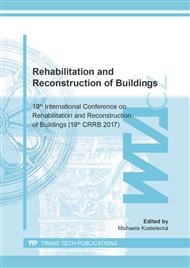p.140
p.147
p.153
p.160
p.167
p.177
p.185
p.191
p.197
Contribution to Solving the Damp Masonry of the Romanesque Church
Abstract:
The paper deals with damp investigation of the St Giles Church in Milevsko Monastery which is an important example of the Romanesque religious architecture. Non-invasive rehabilitation measure, designed by authors and based on detailed damp investigation and analysis, gives support natural moisture movement in structure and respects outstanding importance of this unique Romanesque monument. Protection of building against water and moisture belongs to the most important measures in ensuring the service life and serviceability of historical buildings.
Info:
Periodical:
Pages:
167-176
Citation:
Online since:
August 2018
Authors:
Price:
Сopyright:
© 2018 Trans Tech Publications Ltd. All Rights Reserved
Share:
Citation:


